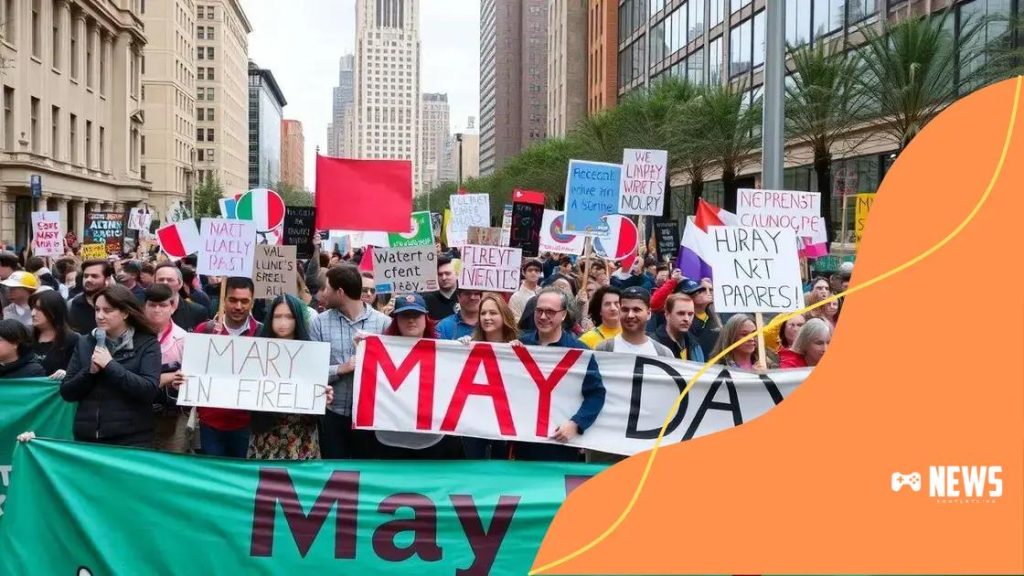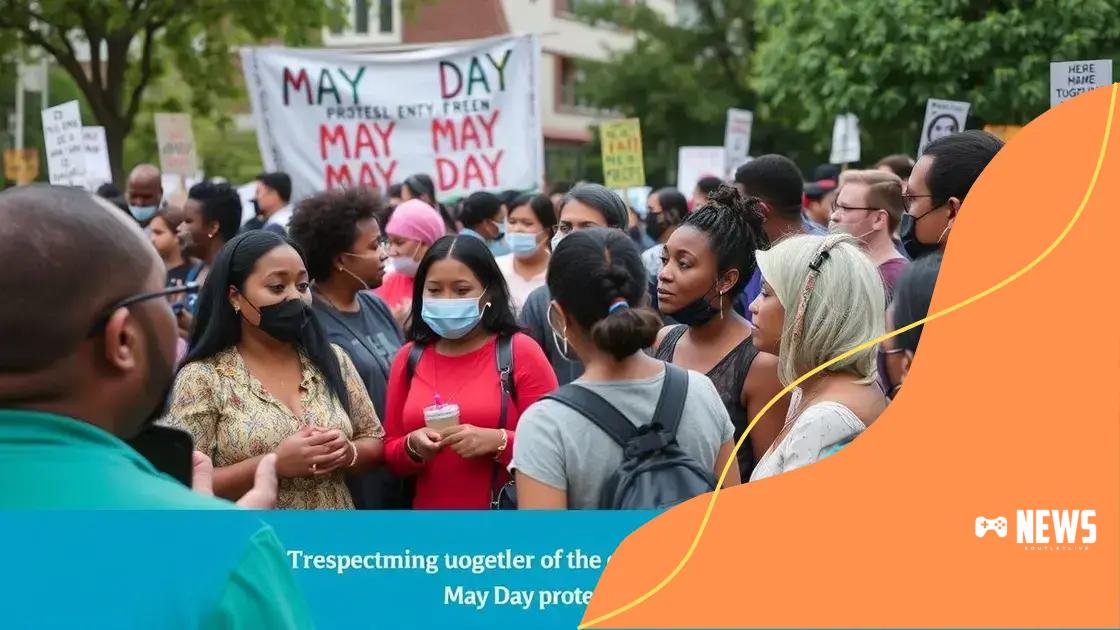May Day protests across the U.S. reveal growing tensions

May Day protests across the U.S. demand social justice and workers’ rights, highlighting issues like fair wages and environmental sustainability while uniting diverse communities for meaningful change.
May Day protests across the U.S. have become a focal point for various movements calling for social justice and workers’ rights. With each passing year, the intensity and significance of these demonstrations seem to grow, making it essential to understand their importance.
Historical context of May Day protests
The historical context of May Day protests is rich and complex. Originating from the labor movement in the late 19th century, these protests have evolved significantly over the decades. They initially aimed at achieving better working conditions and fair wages. In the U.S., May Day gained prominence following the Haymarket Affair in 1886, where a peaceful rally for workers’ rights turned deadly.
The Labor Movement’s Impact
During the early years, May Day protests were centered on labor rights. Workers organized to demand an eight-hour workday, which was a revolutionary idea at that time. These early protests laid the groundwork for modern labor rights but also faced significant pushback from authorities.
Significant Milestones
- The establishment of Labor Day in the U.S. in 1894 diluted the focus on May Day.
- The protests saw a resurgence during the Civil Rights Movement, where they merged with calls for social justice.
- Global events such as the anti-war movements of the 1960s also revived the spirit of May Day protests.
- Recent years have seen a new wave of activism focusing on immigrant rights and economic inequality.
As society faced different challenges, the May Day protests adapted, reflecting the needs and priorities of their times. Today, these events are not just about labor; they encompass broader social issues such as immigration and civil rights. Millions across the globe participate, making it a powerful symbol of unity and resistance.
Key demands of activists
The key demands of activists during May Day protests highlight the urgent issues facing communities. Each year, these demonstrations bring together voices from various backgrounds, united by common goals. One of the primary demands is for worker rights, seeking fair wages and improved working conditions.
Essential Topics Addressed
Activists also focus on social justice issues, advocating for equality and representation in all areas of society. This includes rights for immigrants, LGBTQ+ individuals, and people of color. The intersectionality of these movements strengthens their message, resonating more with the public.
Demands Emphasized by Marchers
- A call for a living wage that reflects the cost of living.
- Safe working environments free from discrimination.
- Comprehensive immigration reform to protect vulnerable populations.
- Affordable healthcare and education accessible to all.
As these protests unfold, the message is clear: activists are not just fighting for themselves, but for future generations. Their voices echo the struggles of the past while pushing toward a more inclusive and equitable future. The demands during May Day reflect not only immediate concerns but also a vision for systemic change.
Impact of protests on communities

The impact of protests on communities is profound and multifaceted. May Day protests serve as a rallying point, uniting people around shared goals. These events can foster a sense of solidarity among diverse groups, encouraging individuals to come together for common causes.
Positive Changes Brought by Activism
One significant effect of protests is the awareness they raise about social issues. Communities often see increased discussions on topics like workers’ rights and social justice. This can lead to legal changes and improved policies that benefit the community as a whole.
Challenges Faced
While protests can lead to progress, they can also present challenges. Neighborhoods may experience disruptions, such as traffic changes or heightened police presence. These factors can create tension between protestors and local residents. However, many argue that the temporary disturbances are worth the benefits gained from the activism.
- Increased engagement in local politics among community members.
- Heightened awareness of social and economic issues.
- Motivation for collective action to address local needs.
- Encouragement for more inclusive community dialogues.
Overall, the role of protests in shaping community dynamics cannot be overstated. They not only highlight existing issues but also inspire collective efforts toward meaningful change. The energy and passion displayed during these events can leave a lasting imprint on neighborhood identities and future advocacy work.
Media coverage and public perception
The media coverage and public perception of May Day protests play a crucial role in shaping the narrative around these events. News outlets often provide a platform for activists to share their messages, and the way these events are reported can influence public understanding.
Influence of Media Representation
Media coverage can highlight important issues raised during the protests, such as worker rights and social justice. However, the portrayal can also vary greatly depending on the outlet’s perspective. Some may focus on the disruptions caused by protests, while others emphasize the message of unity and change.
Public Reaction
Public reaction to media coverage can lead to significant shifts in opinion. When positive stories circulate, public support for the causes of May Day protests can increase. Conversely, negative portrayals can foster skepticism and resistance among those not directly involved.
- Social media has transformed how events are shared, allowing activists to spread their messages directly.
- Increased accessibility to information can lead to more informed public opinions.
- Images and videos shared online can evoke strong emotional responses, swaying public perception.
- Community leaders often use media channels to articulate their stances and mobilize support.
As we can see, the impact of media coverage and the resulting public perception are intertwined. While the protests aim to bring about social change, how they are reported can greatly affect their effectiveness and acceptance within the broader community. It’s essential to critically evaluate media narratives to understand the full scope of the issues at hand.
Future of May Day movements in the U.S.
The future of May Day movements in the U.S. holds promising possibilities as societal needs continue to evolve. As more people become aware of social issues, the relevance of these movements grows. Activists are increasingly using technology and social media to connect and mobilize, creating a new landscape for advocacy.
Emerging Trends in Activism
One trend is the increasing focus on intersectionality, where various social issues intersect. This approach allows movements to address concerns such as environmental issues along with labor rights and immigration reform. As a result, May Day events are becoming platforms for a broader range of voices.
Role of New Generations
Young activists are stepping up to lead the charge. They are leveraging social media to organize and spread their messages quickly. This digital activism is not just changing how protests are organized but also the topics that are prioritized. Issues such as climate change, racial equality, and mental health are gaining prominence.
- Increased collaboration among various activist groups.
- Stronger emphasis on sustainability and environmental justice.
- Global solidarity movements connecting local protests to international causes.
- Heightened engagement with policy-making processes.
As the U.S. grapples with economic and social challenges, the May Day movements will likely remain a crucial part of the dialogue. The ongoing fight for rights and justice continues to inspire people across the nation, and adapting to new issues and technologies will strengthen their impact for future generations.
FAQ – Frequently Asked Questions about May Day Protests
What is the significance of May Day protests?
May Day protests highlight social justice issues and workers’ rights, uniting various groups for a common cause.
How do media reports impact public perception of protests?
Media coverage can shape how the public views protests, either by emphasizing their messages or focusing on disruption.
What role do young activists play in May Day movements?
Young activists lead with fresh ideas and utilize social media to mobilize support, shaping the future of these movements.
What are the key demands of modern May Day protests?
Key demands include fair wages, social justice, immigrant rights, and environmental sustainability.





